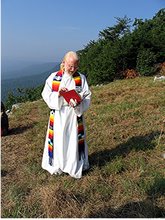FIRST QUESTION: HOW DOES PRACTITIONER DESCRIBE THE STRUCTURE OF HUMAN PERSONALITY? CHAPTER 5
The Faith Teachers
The first article covers the Word of Faith Teachers who do praxis in much the same way as practitioners such as Sigmund Freud, Carl Rogers, and the like. That is, they heal personality dysfunction while self-consciously explaining their work. For those readers not familiar with the Word of Faith teaching, the best known is Kenneth E. Hagin (now deceased). Some of his ideas appear to come from the earlier works of E. W. Kenyon who wrote in the early part of this century. In a personal conversation with the James Buckingham, former Editor-at Large of Charisma magazine, he suggests that E.W. Kenyon was the grandfather and Kenneth E. Hagin Sr. the father of the Faith movement who popularized the teachings and then spawned others such as Charles Capps, Kenneth Copeland, Norvell Hayes, Fred Price, Jerry Savelle, John Osteen and others. Other famous names who, around the same time, arrived at similar conclusions about faith, but from different traditions were P. Cho, T. L. Osborne and Lester Sumrall. Today, there are many others all over the world who have their original roots in this school of thought, not to mention how much of these teachings have permeated throughout Christian practice.
In order to make the writings of the Faith Teachers parallel the major psychologist’s theories of personality, all I had to do was to answer Rychlak’s questions of a theory of personality.
FAITH TEACHING STRUCTURAL CONSTRUCTS
The first question required of a personality theory is to describe the structure of personality, i.e., “What theoretical analogies and metaphors are used in creating the outline of consistent behavior enabling us to speak of personality?” (Rychlak, 1981 p.31)
Again, most people know of Freud’s id, ego and superego. Just as Freud had his id, ego and superego, Kenyon (1970) describes a three part division. There are the spirit, the soul and the body. “Man is a spirit being. He has a soul, and he lives in a physical body.” The three different structures of the personality are further amplified by Hagin (1979) as serving three different functions: “With the body I contact the physical realm. With my spirit I contact the spiritual realm. (and) with my soul I contact the intellectual realm”
Spirit
Hagin apparently became aware of this tri-partite division of his personality after an “out-of-body” experience in his youth. The experience left him with the distinct impression of these three structures to his personality. Later Hagin and others were influenced by Kenyon’s writings as they developed the concept of the spirt as a distinct structure. Kenyon (1966) taught that God is a spirit, angels and demons are spirits and humans are spirits. When the Holy Spirit infuses the human spirit, then the personality is returned to God’s class of Spirit. Now the individual’s spirit can make direct contact and communicate spirit to Spirit.
Although St. Paul was not careful in systematically using words for his own personality, in 1 Cor. Chapt 14:15 he reveals clearly that he was aware of two distinct structures to his personality, each with its own function. “ What is it then? I will pray with the spirit, and I will pray with the understanding also: I will sing with the spirit, and I will sing with the understanding also.”
Soul
Kenyon (1966) departed from the popular use of the word “soul,” the one my denomination used in the seminary at the time I attended, in describing this second structure of personality. In those days, I was just taught we had a soul and a body. Kenyon and Hagin’s use of the word “soul” is similar to Paul’s use of “understanding” in the Scripture above. For Kenyon, the soul is that which is derived through the senses: this then includes the cognitions, the will and the emotions. The term he preferred was “sense knowledge” which he used interchangeably with the term “soul.” Just as Paul taught in 1 Cor. 2, sense knowledge is incapable of knowing God.
The clearest teaching of this inability for sense knowledge to access God is found in the mediaeval mystic St. John of the Cross. In his classic “Dark Night of the Soul,” he describes how the sense knowledge, or soul, panics and goes dark (flat lines) when it suspects there is another part of the personality “the spirit” carrying out actions which cannot be accessed by its mental activity.
Kenyon points out that a central problem of sense knowledge is that it produces a form of faith in information obtained through the senses, which then claims hegemony over the entire system. He paraphrases Romans 8:5-7 “For they that are after the senses have the mind of the senses, but they that are after the spirit, have the mind of the spirit. . . . The mind of the flesh (that is, the thinking that derives its evidence from the senses) is enmity against God.”
Body
Hagin equates the body with the senses. The body is the source of the information which is creating the soul’s experiences. It is also the outward man that is perishing, in contrast to the inward man, or spirit. The spirt is being renewed day by day. The body has to be brought under the control of the spirit eventually (not soul or mind control such as in Christian Science).
Thursday, June 28, 2012
HOW THE THEORIST DESCRIBES THE STRUCTURE OF PERSONALITY
Posted by
Blogger
at
6:13 PM
![]()
Labels: E.W. Kenyon, Faith Teachers, Kenneth Hagin, Theory of Personality
Subscribe to:
Post Comments (Atom)





0 comments:
Post a Comment